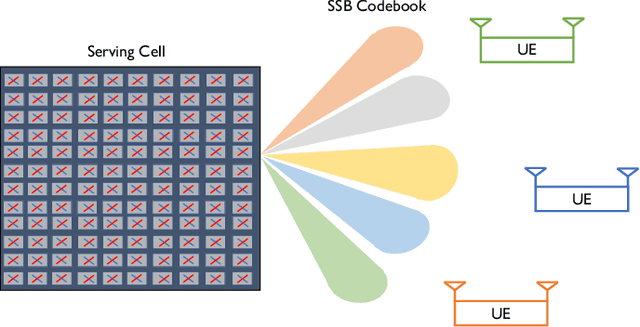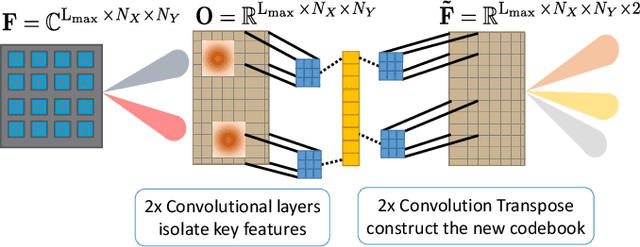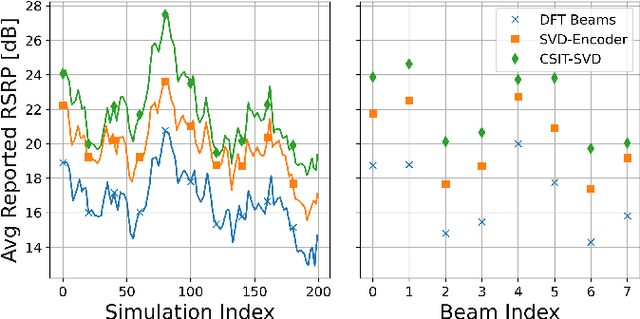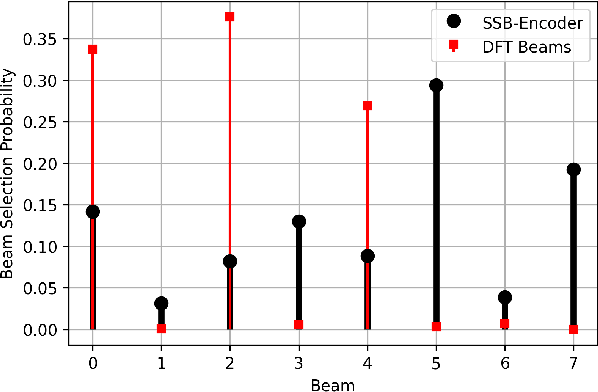Ryan M. Dreifuerst
Beam Training in mmWave Vehicular Systems: Machine Learning for Decoupling Beam Selection
Apr 16, 2024Abstract:Codebook-based beam selection is one approach for configuring millimeter wave communication links. The overhead required to reconfigure the transmit and receive beam pair, though, increases in highly dynamic vehicular communication systems. Location information coupled with machine learning (ML) beam recommendation is one way to reduce the overhead of beam pair selection. In this paper, we develop ML-based location-aided approaches to decouple the beam selection between the user equipment (UE) and the base station (BS). We quantify the performance gaps due to decoupling beam selection and also disaggregating the UE's location information from the BS. Our simulation results show that decoupling beam selection with available location information at the BS performs comparable to joint beam pair selection at the BS. Moreover, decoupled beam selection without location closely approaches the performance of beam pair selection at the BS when sufficient beam pairs are swept.
Neural Codebook Design for Network Beam Management
Mar 05, 2024Abstract:Obtaining accurate and timely channel state information (CSI) is a fundamental challenge for large antenna systems. Mobile systems like 5G use a beam management framework that joins the initial access, beamforming, CSI acquisition, and data transmission. The design of codebooks for these stages, however, is challenging due to their interrelationships, varying array sizes, and site-specific channel and user distributions. Furthermore, beam management is often focused on single-sector operations while ignoring the overarching network- and system-level optimization. In this paper, we proposed an end-to-end learned codebook design algorithm, network beamspace learning (NBL), that captures and optimizes codebooks to mitigate interference while maximizing the achievable performance with extremely large hybrid arrays. The proposed algorithm requires limited shared information yet designs codebooks that outperform traditional codebooks by over 10dB in beam alignment and achieve more than 25% improvements in network spectral efficiency.
Hierarchical ML Codebook Design for Extreme MIMO Beam Management
Nov 24, 2023Abstract:Beam management is a strategy to unify beamforming and channel state information (CSI) acquisition with large antenna arrays in 5G. Codebooks serve multiple uses in beam management including beamforming reference signals, CSI reporting, and analog beam training. In this paper, we propose and evaluate a machine learning-refined codebook design process for extremely large multiple-input multiple-output (X-MIMO) systems. We propose a neural network and beam selection strategy to design the initial access and refinement codebooks using end-to-end learning from beamspace representations. The algorithm, called Extreme-Beam Management (X-BM), can significantly improve the performance of extremely large arrays as envisioned for 6G and capture realistic wireless and physical layer aspects. Our results show an 8dB improvement in initial access and overall effective spectral efficiency improvements compared to traditional codebook methods.
Initial Access Codebook Design and CSI Type-II Feedback for Sub-6GHz 5G NR
Mar 06, 2023Abstract:Beam codebooks are a recent feature to enable high dimension multiple-input multiple-output (MIMO) in 5G new radio (NR). Codebooks comprised of customizable beamforming weights can be used to transmit reference signals and aid the channel state information (CSI) acquisition process. In this paper, we characterize the role of each codebook used during the beam management process and design a neural network to find codebooks that improve overall system performance. Evaluating a codebook is not purely about maximizing signal power, but instead, a holistic, system-level view of effective spectral efficiency is necessary to capture the relationships between codebooks, feedback, and spectral efficiency. The proposed algorithm is built on translating codebook and feedback knowledge into a consistent beamspace basis similar to a virtual channel model to generate initial access codebooks and select the subsequent refined beam training. This beamspace codebook algorithm is designed to directly integrate with current 5G beam management standards. Simulation results show that the neural network codebooks improve over traditional codebooks in received signal power, even in dispersive sub-6GHz environments. We further utilize our simulation framework to evaluate type-II CSI feedback formats with regard to effective multi-user spectral efficiency. Our results suggest that optimizing codebook performance can provide valuable spectral efficiency improvements, but 5G feedback quantization resolution limits multi-user performance in sub-6GHz bands due to the rich scattering environment.
Massive MIMO in 5G: How Beamforming, Codebooks, and Feedback Enable Larger Arrays
Jan 31, 2023Abstract:Massive multiple-input multiple-output (MIMO) is an important technology in fifth generation (5G) cellular networks and beyond. To help design the beamforming at the base station, 5G has introduced new support in the form of flexible feedback and configurable antenna array geometries. In this article, we present an overview of MIMO throughout the mobile standards, highlight the new beam-based feedback system in 5G NR, and describe how this feedback system enables massive MIMO through beam management. Finally, we conclude with challenges related to massive MIMO in 5G.
Massive MIMO Beam Management in Sub-6 GHz 5G NR
Apr 12, 2022



Abstract:Beam codebooks are a new feature of massive multiple-input multiple-output (M-MIMO) in 5G new radio (NR). Codebooks comprised of beamforming vectors are used to transmit reference signals and obtain limited channel state information (CSI) from receivers via the codeword index. This enables large arrays that cannot otherwise obtain sufficient CSI. The performance, however, is limited by the codebook design. In this paper, we show that machine learning can be used to train site-specific codebooks for initial access. We design a neural network based on an autoencoder architecture that uses a beamspace observation in combination with RF environment characteristics to improve the synchronization signal (SS) burst codebook. We test our algorithm using a flexible dataset of channels generated from QuaDRiGa. The results show that our model outperforms the industry standard (DFT beams) and approaches the optimal performance (perfect CSI and singular value decomposition (SVD)-based beamforming), using only a few bits of feedback.
 Add to Chrome
Add to Chrome Add to Firefox
Add to Firefox Add to Edge
Add to Edge